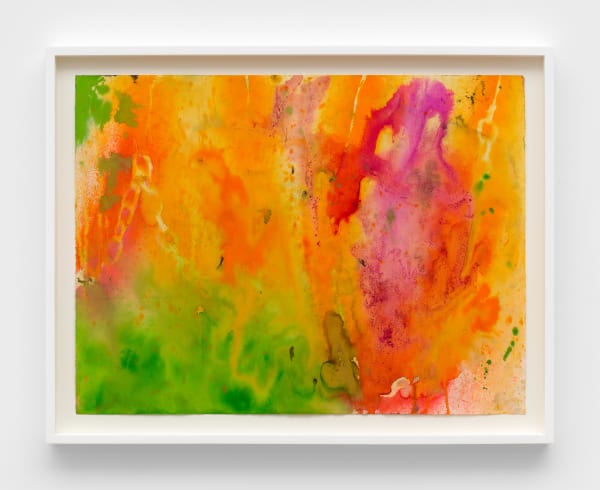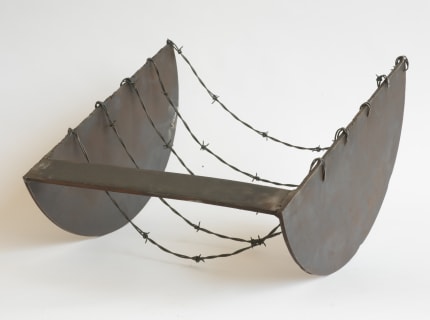Melvin Edwards: Lots of Work to Do
-
Overview
Alexander Gray Associates, New York presents Melvin Edwards: Lots of Work to Do, the artist’s eighth solo show with the Gallery. A focused survey of nearly sixty years of work, the exhibition takes its title from the artist’s 2019 interview with The Museum of Modern Art in which he outlines his commitment to “… making sculpture … that will remind my human compatriots in the world that we got lots of work to do.” Featuring a selection of freestanding sculptures, wall reliefs, and works on paper, the show highlights Edwards’s ability to weld personal and collective memories into steel—an action that charges his work with a political urgency that resonates today.
Edwards created Lynch Fragment Landscape (1963–64) the same year as Some Bright Morning (1963), his first Lynch Fragment. Much like this series of wall reliefs, Landscape incorporates industrial and agricultural tools, as well as scrap metal, into its structure. By presenting objects associated with mechanical and artistic production that can also serve as weapons, the sculpture invites overlapping interpretations centered around labor, creativity, and oppression. “Metaphorically, I wanted to load it up,” Edwards explains. “I really did want to find some way to have my concerns about social matters be some sort of starting point for my work.” Distinguished by their evocative materiality, works like Homage to the Music and the Musicians (1966), abstract African instruments into basic geometric volumes. Roughly arranging each form—allowing them to bounce against one another until they achieve a delicate balance—Edwards suggests the pounding dynamism of percussion.
Similarly, Pamberi (1988) uses its rocker form to translate the pendulum-like kineticism of Alexander Calder and Jean Tinguely’s works into a syncopated motion that recalls the rhythmic structures of African Diaspora music. As Edwards outlines, “When I rocked … it lagged behind in terms of gravity … So it affects what would be the normal balance. … So I said, whoa, [this] syncopates the motion of the rocker! … And I use the word with a sense of sensitivity to syncopation used in relation to African American music, as an emphatic quality.” For Edwards, there is an intrinsic connection between welding and composing music. Creating a sculpture from salvaged scrap—uniting disparate pieces of steel imbued with polytemporal cultural histories—is akin to, he argues, “… creating music. ... The same sound one time is a beautiful high point in an aria, another time it's just a scream.”
Simultaneously aria and scream, Edwards’s Lynch Fragments like Tilt (2015) transform tools for work and violence—chains, railroad spikes, hammers, pipes, etc.—into a sculptural language that gives voice to multiple narratives. Complicating the series’ direct connection between material and form, the artist notes, “The work has nothing that is literal. … There are some elements like chains, people love to jump to slavery and oppression—that can be, but nobody remembers why chains were invented. … I know that’s the human invention of a stronger kind of rope. Everything else is implication.” Also dealing in implication, Edwards’s 1970s works on paper feature brightly colored silhouettes of barbed wire and chain, creating a jarring disjunction between the pictured materials and their potential use.
Deliberately siting his work in this disjunction, Edwards reminds viewers that there is still work to do. Rooted in process, his sculptures and drawings look backwards and forwards, across generations and continents, to reflect on social and political events. As Edwards once concluded, “Yesterday always proposes tomorrow.”
Edwards’s work is the subject of the 2024 survey Some Bright Morning, presented by the Fridericianum in Kassel, Germany; this exhibition will travel to Kunsthalle Bern, Switzerland and Palais de Tokyo, Paris, France in 2025 and 2026. Other major retrospectives of his work include Melvin Edwards: Five Decades, Nasher Sculpture Center, Dallas, TX (2015), traveled to Zimmerli Museum of Art, Rutgers University, New Brunswick, NJ (2015) and to Columbus Museum of Art, OH (2016), and Melvin Edwards Sculpture: A Thirty-Year Retrospective 1963–1993, Neuberger Museum of Art, State University of New York at Purchase (1993), traveled to The Art Museum at Florida International University, Miami (1994), Hood Museum of Art, Dartmouth College, Hanover, NH (1994), and to McNay Art Museum, San Antonio, TX (1995). His work has been the subject of solo exhibitions at Dia Beacon, NY (2022); deCordova Sculpture Park and Museum, Lincoln, MA (2022); Public Art Fund, City Hall Park, New York, NY (2021); Baltimore Museum of Art, MD (2019); and Museu de Arte de São Paulo, Brazil (2018), among others. He has also participated in numerous group exhibitions, including New York: 1962–1964, The Jewish Museum, New York, NY (2022); The Dirty South: Contemporary Art, Material Culture, and the Sonic Impulse, Virginia Museum of Fine Arts, Richmond (2021), traveled to Contemporary Arts Museum Houston, TX (2021); Soul of a Nation: Art in the Age of Black Power,Tate Modern, London, United Kingdom (2017), traveled to Crystal Bridges Museum of American Art, Bentonville, AK (2018), Brooklyn Museum, NY (2018), The Broad, Los Angeles, CA (2019), de Young Museum, Fine Arts Museums of San Francisco, CA (2019), and The Museum of Fine Arts, Houston, TX (2020); Postwar: Art Between the Pacific and the Atlantic 1945–1965, Haus der Kunst, Munich, Germany (2016); and the 56th Venice Biennale: All the World’s Futures, Italy (2015). Edwards’s work is represented in the collections of the Brooklyn Museum, NY; Dia Art Foundation, NY; Los Angeles County Museum of Art, CA; The Metropolitan Museum of Art, New York, NY; The Museum of Modern Art, New York, NY; National Gallery of Art, Washington, D.C.; San Francisco Museum of Modern Art, CA; The Studio Museum in Harlem, New York, NY; and Whitney Museum of American Art, New York, NY, among others. Edwards taught at Rutgers University, The State University of New Jersey, from 1972 to 2002. In 2014, he received an honorary doctorate from the Massachusetts College of Art and Design, Boston. Edwards is also represented by Stephen Friedman Gallery, London, and Galerie Buchholz, Berlin and New York.
Edwards dedicates Lots of Work to Do to the memory of Amadou Mahtar M’bow, the first African Director General of UNESCO. Edwards was a great admirer of M’bow’s advocacy for other peoples and cultures and deeply mourns his passing earlier this year.
-
Installation Shots
-
Artworks
-
Artists







